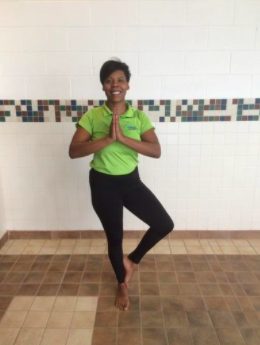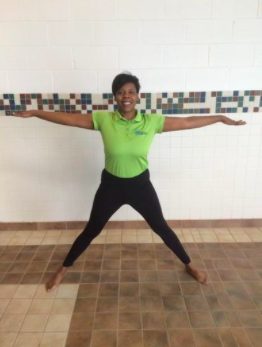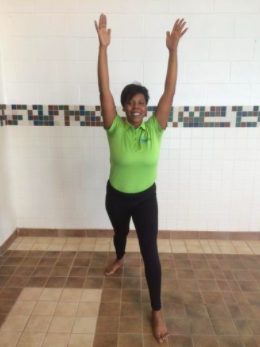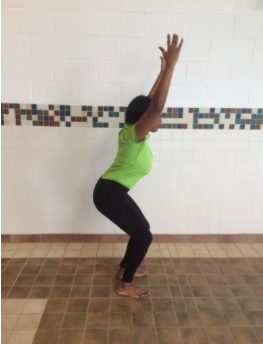Learn How to Jump Into the Latest Exercise Trend: Aquatic Yoga
Aquatic yoga class participation doubled during the past year at Twin Towers Senior Living Community. That’s because aquatic exercise continue to get results and grow in popularity with seniors. So more fitness instructors are integrating land movements into the water.
Water helps hold us up and removes pressure from the joints. Participants gain confidence that they can do yoga as fully as possible when they are in the water and get relief from pressure on the joints.
Four Aquatic Yoga Poses for Beginners
The starting position for all movements is the Mountain Pose.
- Begin with a neutral stance–stand tall, feet shoulder width apart, shoulders over hips, over knees and over ankles.
- Head facing forward, chin parallel to pool floor, knees soft, feet facing out and forward.
- Core muscles engaged.

1. Tree Pose
- In Mountain Pose, shift weight to left foot.
- On exhale bring right knee up.
- Inhale turn right knee out.
- Exhale, place right foot on left ankle where it is comfortable. Focus on how position feels; push foot into leg and leg into food to find stability.
- On inhale, bring arms into prayer, pressing palms into each other, keeping core muscles engaged, pay attention to how your body feels. Lengthen your body by rooting feet into pool floor and lifting crown of head up toward the ceiling.
- Stay in position through 4-6 breaths.
- Exhale arms down.
- Inhale right knee back to front.
- Exhale right leg back to starting position.
- Repeat with left leg.
Expert Tip: Focus on finding YOUR tree pose; all of our trees are different, even if they are the same tree. Find what works for you.

2. Star Pose
- In Mountain Pose, inhale as legs open as wide as comfortable.
- On exhale pulling tailbone forward and down.
- Inhale arms to shoulder height, relaxing shoulders, stretching fingertips toward sides of pool, lifting crown of head up to ceiling, and stretching body out.
- Stay in position through 4–6 breaths.
- Exhale arms down.
- Inhale legs back to starting position.
Expert Tip: When you lift your arms up, look across at them to be certain they are at shoulder height.
3. Warrior Pose

- In Mountain Pose, on exhale, pull right leg back behind, pull hips forward, adjust yourself to feel stable in position. Take several breaths as you adjust to stabilize your body. Right foot is at about a 45-degree angle.
- On inhale, pull knee over left ankle, push knee out toward little toe, engage core muscles.
- Take several breaths as you adjust to stabilize your body.
- Inhale arms up overhead, reach fingertips, gaze is straight ahead.
- Stay in position through 4-6 breaths.
- Exhale arms down.
- Inhale body back to starting position.
- Repeat with left leg.
Expert Tip: If you hunch your shoulders when your arms are up, push them back and down close to ears.

4. Chair Pose
- In Mountain Pose, on the inhale, bring arms up, reach fingertips to ceiling. Arms can also be lowered to chest pressing hands together in front in prayer.
- On exhale sit, pay attention to knees because they may try to buckle in, pull them out toward pinky toe. Bringing tailbone in, pulling forward and pointing down toward floor of pool, core muscles engaged and keeping back straight.
- Hold position for 4-6 breaths.
- Inhale yourself up, bringing arms down, returning to starting position.
If assistance is needed to maintain balance and proper position in any of the poses, hold on to the side of the pool, or hold hands out at sides. Always work within your own range of motion, and if something hurts, stop immediately.
The Importance of Breathing in Aquatic Yoga
As you practice yoga, try to stay in a rhythm of breathing with your movements to keep that mind-body connection. Focus on inhaling when the body opens and exhaling when the body closes. It’s ok if you inhale when a movement calls to exhale; eventually, it will come naturally.
Proper breathing techniques, whether during aquatic yoga or with regular breathing exercises, can lower stress and improve your overall health.
Subscribe to Life Enriching Communities Blog
"*" indicates required fields